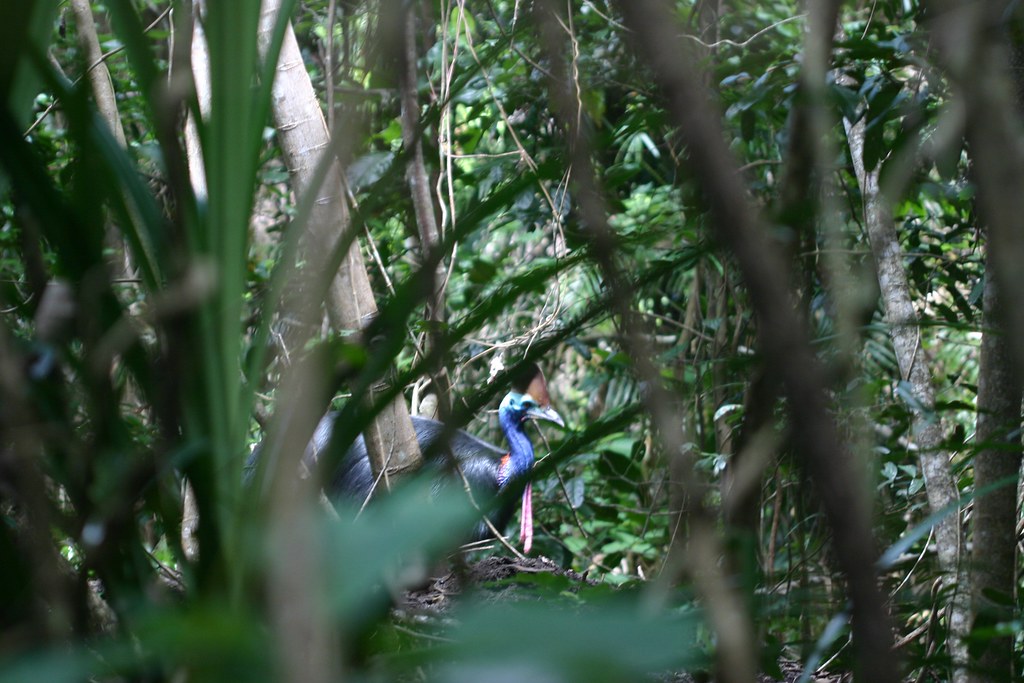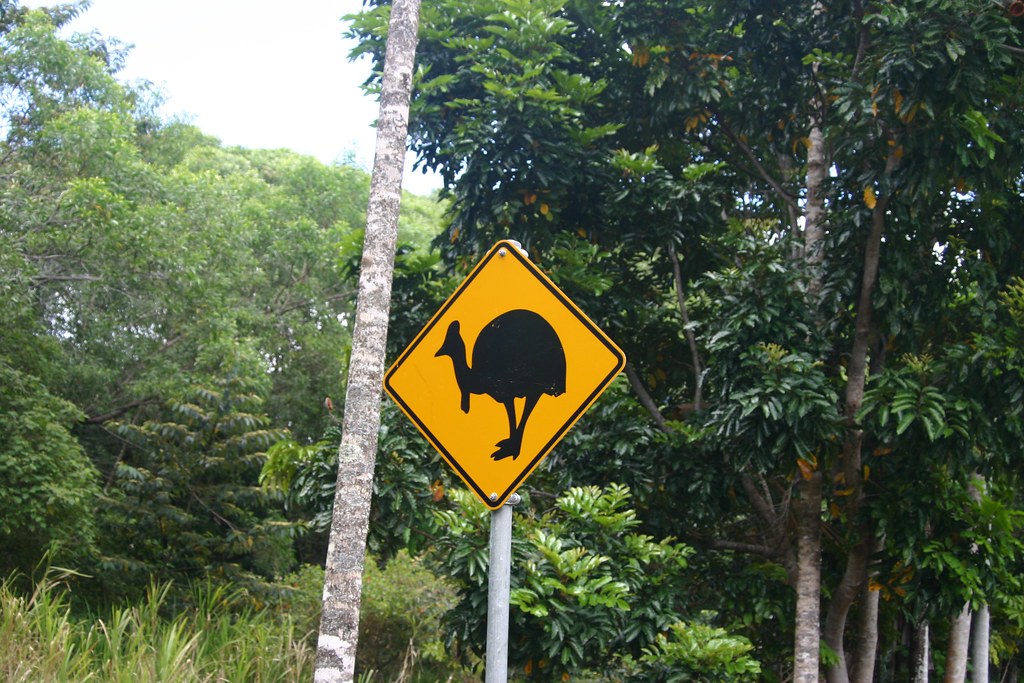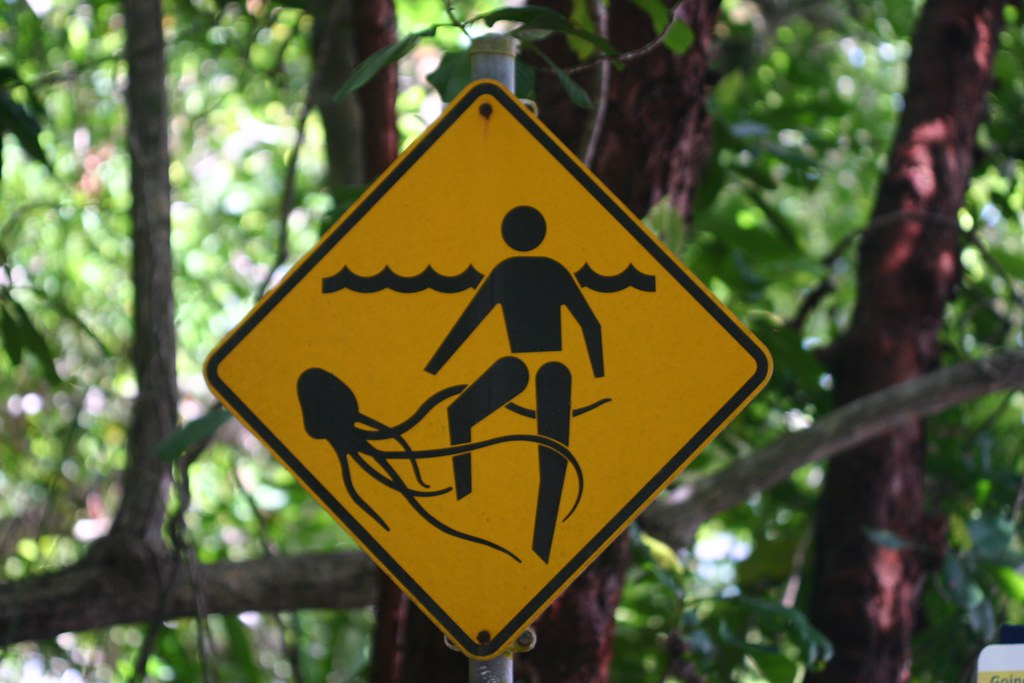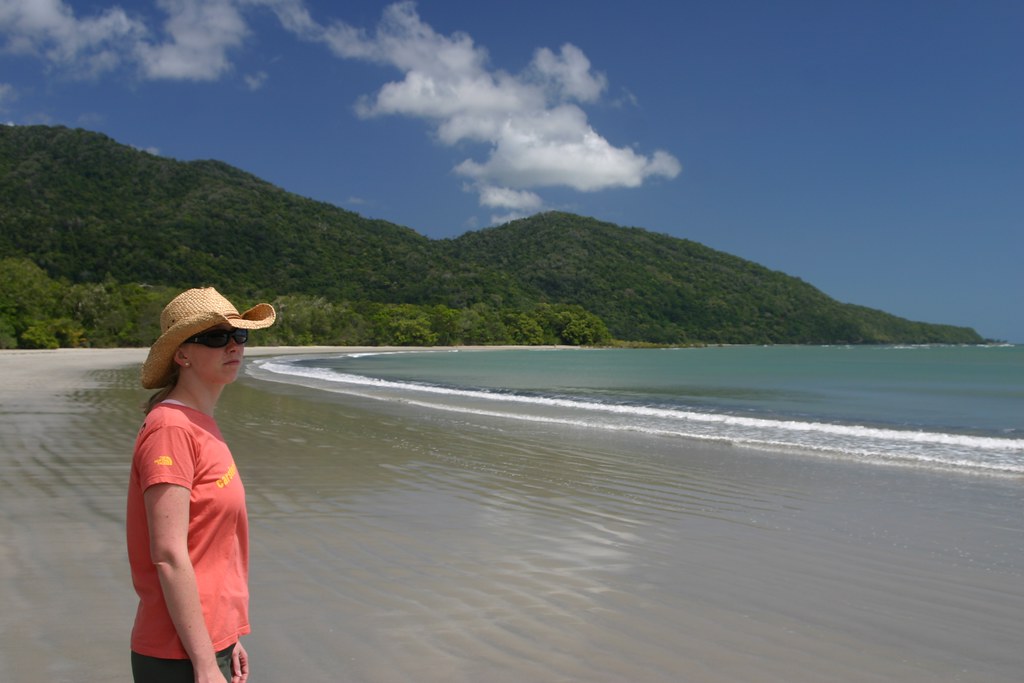We saddled up the Camry around 9:00AM at the hotel and took off to the north. Our drive into the Daintree region took about 90 minutes and included a car ferry across the
Daintree River. The landscape became noticeably greener the further we drove.
 Mouth of the Daintree River as a backdrop
Mouth of the Daintree River as a backdropThe road hugging the coast is tight and winding but the traffic is thin and slow – most people were enjoying the scenery like us. We stopped at a couple pullovers, but eventually made our way to a driveway leading to the Cape Tribulation beach. We parked the car and walked over to some commotion in the woods behind us. It was a Cassowary. This bird was massive. We stood at the edge of the brush and took a couple photos from about 25 feet away.
 Cassowary through the trees
Cassowary through the trees
We walked back past the car on the way to the beach and saw the most unnerving sign.
And I quote:
CAUTION
A large cassowary may be present in this area. Naturally cassowaries are shy and reclusive animals however this animal has been approaching people. Any such bold behavior creates a potentially dangerous situation to people and the cassowary.
Under no circumstances should you approach any cassowary, keep your distance and do not run. If the cassowary approaches you, back away while making loud noises (clap, yell).
And a search of Wikipedia delivered this little gem after we returned.
“The 2004 edition of the Guinness World Records lists the cassowary as the world's most dangerous bird. Normally cassowaries are very shy but when disturbed can lash out dangerously with their powerful legs. During World War II American and Australian troops stationed in New Guinea were warned to steer clear of the birds. They are capable of inflicting fatal injuries to an adult human. Usually, attacks are the result of provocation. Wounded or cornered birds are particularly dangerous. Cassowaries, deftly using their surroundings to conceal their movements, have been known to out-flank organized groups of human predators. Cassowaries are considered to be one of the most dangerous animals to keep in zoos, based on the frequency and severity of injuries incurred by zookeepers.
A cassowary's three-toed feet have sharp claws; the dagger-like middle claw is 120 mm (5 inches) long. This claw is particularly dangerous since the Cassowary can use it to kill an enemy, disemboweling it with a single kick. They can run up to 50 km/h (32 mph) through the dense forest.”
 Passing a cassowary on the road was the least of our worries
Passing a cassowary on the road was the least of our worries
I also found numerous accounts of things going wrong around cassowaries.
In April of 1995, Doon McColl was jogging along this trail, when she heard a noise behind her. She turned to see a full size adult cassowary running after her, so she ran like hell and then climbed a tree. The big bird waited below for hours later until it finally wandered off. A week later her boyfriend, Ray Willetts, was also chased. He tried to lose the bird in the jungle and spent the day crashing through thorns and lawyer cane while the huge bird followed effortlessly.
I recall listening to a local Cairns radio station where a bloke rang up to tell his cassowary adventure and when the DJ started making a joke out of it the man on the phone became agitated and said; look mate, it was not f#&#ing funny, I never been so scared in all my life!
One day in 2003 several men were training as guides for Mason's guided walks in Cape Tribulation when they encountered a cassowary on one of the trails in the rainforest. Rather than to go behind a tree they chose to run and if there's anything a cassowary regards good fun it is chasing people so they ran for miles with the big bird in pursuit. The national parks ranger in Cape Tribulation gets 'cassowary attack' reports from time to time from the tourists but all that has usually happened is that they were chased for some distance, if the bird doesn't catch up with you that means he is not trying to, as they can easily run three times as fast as people.
Two cassowaries with two chicks often hangout on the beach and around the picnic area at Cape Tribulation beach and this has resulted several times in encounters of the bird kind. One of the crew members of Rum Runner reef trips was chased around the picnic area for some time, doing circles around trees, even his football dodging techniques did not help, and he finally ran in to the sea to escape the territorial cassowary that would not give up.
Whilst picking mangosteens, I was standing under the trees looking up - Buttons my dog was sitting beside me. I heard this hissing noise beside me and jumped behind the mangosteen tree to get out of the way of whatever was behind me. It was an adult cassowary and we happened to be between her and her two chicks about 4 metres away. In the flash of a second, the adult bird literally took a huge jump and landed on the sitting dog. Her foot caught Buttons side and with my cries of "run Buttons, run....." we both scrambled along the row of trees and away from the very agitated cassowary. The chicks never seemed disturbed by the event and went on grazing along the fruit tree rows. Buttons went to the Mossman Vet for stitches (12) and I went to pay the bill of $260. This adult cassowary has successfully raised many chicks that we know of and from now on our dogs will stay close to the house and not accompany us to the orchard.
A couple was on the way down from Mount Sorrow when they were chased by a large cassowary. When all attempts to shake off the bird or to stand their ground failed they laid down in the mud and played dead. This calmed the bird, that had been hissing and breathing heavily before. Unfortunately the bird then sat down next to them and kept them prisoner, every time they made the slightest move the cassowary would get up and make threatening moves again. After about 40 minutes of being kept prisoner two other hikers came past on the track and the cassowary got up and went after them, and the lucky couple got up and rapidly made their way down the hill and back to their cabin at Rainforest Hideaway.
Anyway. It was unknowingly a near-death experience and we are survivors. Amy and I now appreciate every second that we are alive.
The beach a Cape Tribulation is perfectly serene. Like other beaches in Far North Queensland, the ghost crabs get to work on the beach a couple of hours after the tide rolls out and put the beach through an amazing visual transformation in about an hour.
To eat they scoop up sand with their lightning fast claws, extract the nutrients out of the sand and leave behind millions of little balls of clean sand in a design best described as organized chaos.
The little dudes are ridiculously hard to see. To a casual observer the beach appears to transform magically with no tangible influence from crabs or anything else. The trick is that the crabs will disappear into their unbelievably deep holes when any other creature is within a football field of their workmanship. Of course I’m much too persistent to let this shifty escape mechanism thwart my scientific accomplishments. I learned that if you camp silently in on area for 5-6 minutes they will become unconcerned and reappear from the depths. You must remain perfectly still; even a big eye blink will send them scurrying back down.
Eventually I was surrounded by dozens of quarter-sized crabs gobbling sand and tossing pea-sized balls behind them. My only disappointment was that I had convinced myself that when they come up they get into a good flurry of activity by singing the chorus of Memphis Bleek’s “We Ballin.”
~~ We ballin. Ready for war, pass the weed and hennessy, I hear it callin ~~
Here are some photos…
 These shorties are ballers
These shorties are ballers

Jellyfish dissolve your hips? OMG!
 Cape Trib
Cape Trib






No comments:
Post a Comment